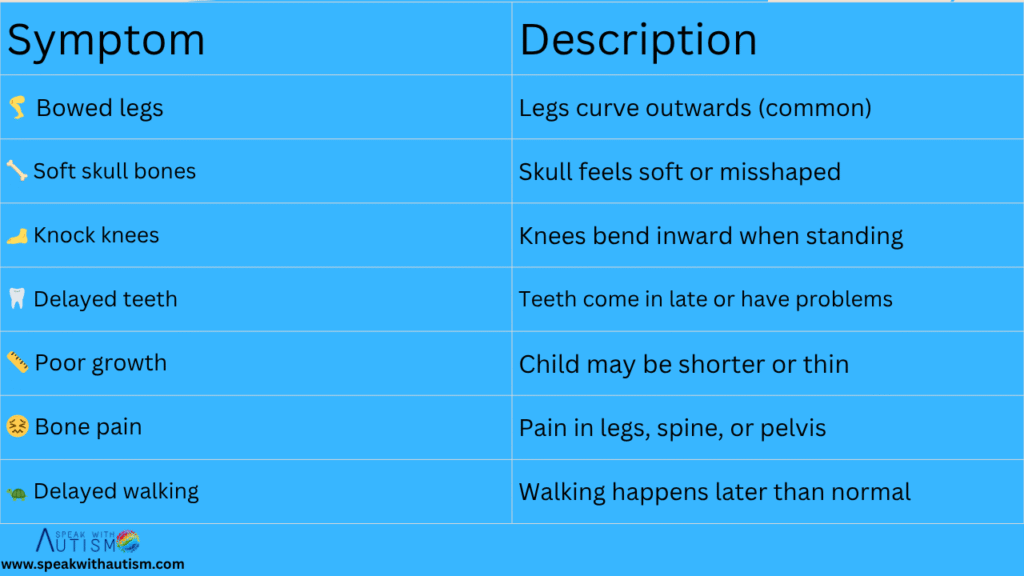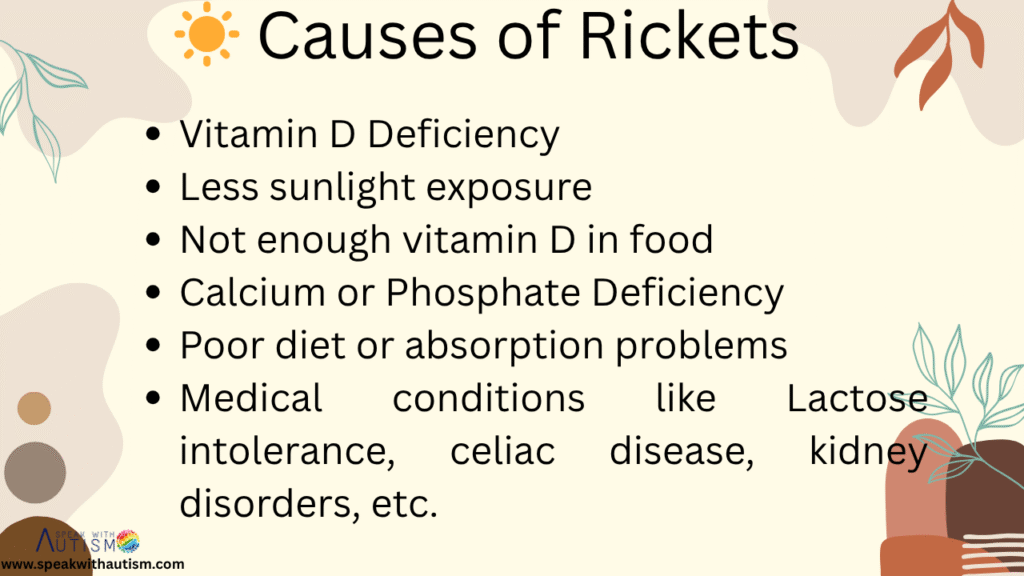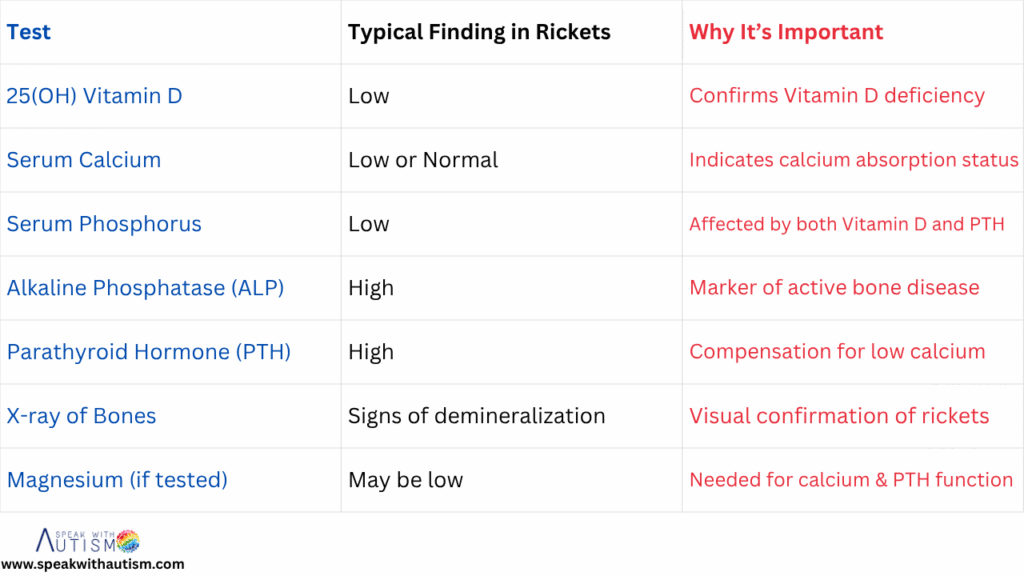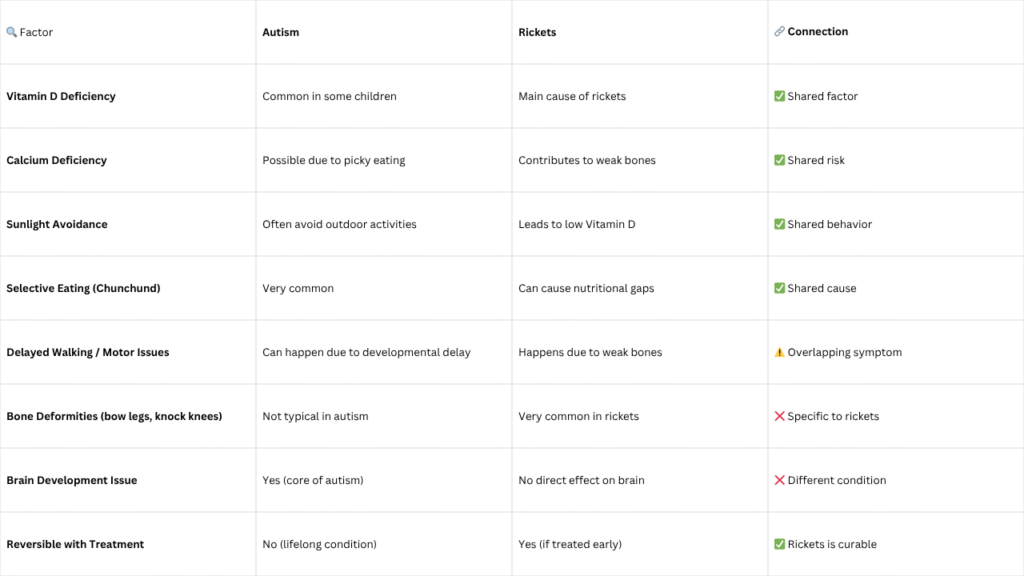Autism and Rickets: Many autistic children eat only certain things (like white food, chips, bread, etc). This causes a deficiency of essential nutrients like calcium, vitamin D, and iron. If this deficiency becomes long-term, rickets can develop.
Rickets = Weak bones in children caused by lack of Vitamin D and calcium.
Table of Contents
Common Signs of Rickets

🧾 My Experience
As a mother of a 5.7-year-old autistic child, I’ve learned that physical health concerns can sometimes silently creep in. Recently, I noticed slight bending in my son’s legs and reduced physical energy. Concerned, I consulted our pediatrician, who suggested some important tests — HMF, Vitamin D3, Calcium, and ALP. The results showed that his Vitamin D3 level was very low, yet his ALP (Alkaline Phosphatase) was at 1191, which is very high. This was a wake-up call for us.
The doctor diagnosed it as an early sign of rickets, a condition I never expected. This personal journey made me aware of how closely autism and nutritional deficiencies can be related, and how essential it is to monitor health parameters regularly in special children.
❓ What Is Rickets and What Causes It?

Rickets is a bone disease that leads to soft, weak, and deformed bones, especially in children. It is most commonly caused by:
- Vitamin D deficiency
- Calcium deficiency
- Phosphorus deficiency
- Genetic disorders affecting mineral absorption
- Kidney or liver problems
- Premature birth (low nutrient stores)
- Malabsorption disorders (like celiac or Crohn’s disease)
Lack of sunlight exposure, unbalanced diet, and certain medical conditions can severely impact a child’s bone health, leading to rickets.
🧪 Key Tests to Diagnose Rickets
If a child shows symptoms like bowed legs, delayed walking, or bone pain, doctors may recommend:
- Vitamin D3 (25-Hydroxy Vitamin D) Test
- Serum Calcium and Phosphorus
- Alkaline Phosphatase (ALP)
- Parathyroid Hormone (PTH)
- X-ray of bones to check bone deformities
- Magnesium levels (if needed)

These tests help detect nutritional deficiencies or underlying conditions affecting bone health.
🤝 How Are Autism and Rickets Related?

Children with Autism Spectrum Disorder (ASD) are often at a higher risk of vitamin and mineral deficiencies. Several factors contribute to this connection:
- Restricted diets due to sensory issues
- Avoidance of dairy or calcium-rich foods
- Less outdoor activity, leading to reduced sunlight exposure
- Gut-related disorders that may hinder nutrient absorption
Thus, children with autism are more likely to develop nutritional rickets if not carefully monitored.
To learn more about supporting autistic children’s health, you can visit my website:
👉 www.speakwithautism.com
🧠 Why Rickets Occurs in Autistic Children
Autistic children often:
- Prefer repetitive or selective foods, excluding key sources of vitamin D and calcium.
- May have sensory aversions to certain food textures (like milk, eggs, or fish).
- Spend less time outdoors, limiting vitamin D production from sunlight.
- Experience gut inflammation or absorption issues.
These combined issues make rickets more likely to occur in autistic children, even if parents feel their diet is “okay.”
How long can rickets be cured?
If rickets is identified on time, it can be easily treated effectively from 6 months to 6–7 years of age.
✅ Ideal Age for Treatment
- The period of 0 to 6 years is most critical because at this age the bones develop rapidly.
- If treatment is started by the age of 10–12 years and the deformity is mild, then there can be improvement.
- After puberty (after 13–14 years) the bones mature and the deformity caused by rickets can be permanent, unless surgery is required.
🛑 What can happen if rickets is not treated?
- Bones can become permanently deformed (example-bowed legs, spine problems)
- Height growth hindered
- Frequent fractures (bones become weak)
- Muscle weakness or chronic pain
- Long-term dental issues
🥦 Nutritional Deficiencies Behind Rickets
The major deficiencies that lead to rickets include:
- Vitamin D – Essential for calcium absorption and bone growth.
- Calcium – Builds and strengthens bones.
- Phosphorus – Works with calcium to form strong bones.
- Magnesium – Supports vitamin D and calcium metabolism.
In children with autism, these deficiencies often arise because of limited food variety, food allergies, or poor gut health.
✅ How to Solve Rickets in Autism
Managing and treating rickets in autistic children requires a holistic and medical approach:
- Consult a pediatrician and a nutritionist for personalized advice.
- Begin Vitamin D3 supplementation (only under medical supervision).
- Add calcium-rich foods: paneer, curd, tofu, ragi, sesame seeds, fortified cereals.
- Ensure safe sunlight exposure for 15–30 minutes a day.
- Use kid-friendly multivitamins or bone health formulas, if recommended.
- Schedule regular blood tests to monitor vitamin D, calcium, and ALP levels.
- Track developmental signs and adjust dietary plans based on the child’s progress.
For more tips on autism care, speech activities, and nutrition, explore helpful articles on my blog:
🔗 www.speakwithautism.com
📌 Final Thought

Rickets is preventable and treatable, especially when diagnosed early. For parents of autistic children, staying alert to subtle health signs and maintaining regular checkups is key. Nutritional care is not just about diet—it’s about giving our special children the foundation for a stronger, healthier future.
❓ FAQ: Rickets and Autism – Parents’ Common Questions
What are the signs of rickets that parents should look for?
Some common signs of rickets that parents should notice:
Legs being sagging** (bow legs or knock-knees)
Weight lifting or difficulty in walking
Late walking or crawling
Bone pain or getting tired quickly
Dental problems (late teething, weak teeth)
Swollen wrists or ribs
Slow growth
Why do children with autism get more rickets?
Autistic children have more chances of getting rickets:
Limited diet due to (selective eating habits)
Refusing dairy products
Less sunbathing, avoiding outdoor activities
Sensory issues, which limit nutritious food intake
Gut issues due to which absorption is less
Is there a direct connection between rickets and autism?
There is no direct biological connection between rickets and autism, but lack of nutrition and outdoor exposure in autism increases the risk of rickets. Both conditions are different but can influence each other — especially in growing children.
If a child is a little late in walking, can that be a sign of rickets?
Yes, late walking or delayed motor milestones can be an early sign of rickets, especially if it is accompanied by stiffness in the legs, bone pain, or poor physical stamina. It is important to get tested.
How is rickets confirmed?
Doctors suggest some important tests:
Vitamin D3 level
Calcium & phosphorus levels
ALP (Alkaline Phosphatase)
X-ray of bones
Sometimes PTH hormone or magnesium test is also done
Is the treatment of rickets different in children with autism?
Treatment is mostly similar, but for children with autism the doctor has to keep these things in mind:
Whether the child accepts supplements or medicines or not
The diet plan should be according to the sensory needs of autism
Multivitamins or calcium powders suitable for taste-sensitive children
Regular follow-up and parent support is necessary
How to prevent rickets in children with autism?
Daily sun* taking (15–30 mins)
Balanced diet with vitamin D, calcium & phosphorus
Fortified foods use (like vitamin D milk, cereals)
Supplements with doctor’s advice
Regular growth and blood check-ups
Can rickets be cured?
Yes, if caught in the early stage, then rickets are fully treatable. With timely supplements, diet changes, and doctor’s guidance bones can become normal. If it is delayed, permanent deformities can also occur.

er6im7